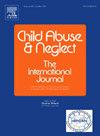血液学与非意外创伤病因的瘀伤鉴定使用急诊科瘀伤途径
IF 3.4
2区 心理学
Q1 FAMILY STUDIES
引用次数: 0
摘要
背景:瘀伤是儿童虐待的常见表现,也是血液学疾病的常见表现。本研究的目的是描述:(1)高风险瘀伤与新的血液病诊断和/或儿童虐待相关的频率,以及(2)与这些诊断相关的患者特征、表现或瘀伤模式。参与者和设置:2020年10月至2023年6月期间,在西雅图儿童急诊科就诊的48个月以下的患者因虐待而出现高风险瘀伤。方法回顾被标记为高风险瘀伤的儿童的病历,并提取与患者病史和出血性疾病和虐待评估相关的数据。结果共发现高危儿童161例。24例血液学实验室结果异常,71%(17/24)获得了指示性随访护理。其中8人患有血液学疾病,包括免疫性血小板减少性紫癜(3)、血管性血友病(4)和阿司匹林诱导的血小板功能障碍(1)。有一半(81/161)的儿童被诊断患有虐待。腿部擦伤在血液病患者中更为常见(5/8,62.5%),而仅滥用的患者(22/79,27.8%,p = 0.043)。8例血液病患者中有4例(50%),63例受虐儿童中有61例(96.9%)有瘀伤位置数据,在TEN(躯干、耳朵、颈部)部位有瘀伤。结论:本研究强调需要多学科方法来评估高危瘀伤儿童,以及有虐待倾向的儿童和血液系统疾病儿童之间的特征重叠。本文章由计算机程序翻译,如有差异,请以英文原文为准。
Hematologic versus non-accidental trauma etiologies for bruising identified using an emergency department bruising pathway
Background
Bruising is a common presentation of child abuse, and a frequent finding in hematologic disorders.
Objectives
This study's aims were to describe: (1) how often high-risk bruising, identified with an established emergency department (ED) pathway, is related to a new hematologic disorder diagnosis and/or child abuse and (2) characteristics of patients, presentation, or bruising patterns associated with these diagnoses.
Participants and setting
Patients under 48-months-old presenting to Seattle Children's ED between October 2020 and June 2023 with high-risk bruising for abuse.
Methods
Charts of children flagged for high-risk bruising were reviewed, and data was extracted related to patient history and evaluation for bleeding disorders and abuse.
Results
161 children with high-risk bruising were identified. Twenty-four had abnormal hematologic lab results, with 71 % (17/24) obtaining indicated follow-up care. Eight had a hematologic disorder, which included immune thrombocytopenic purpura (3), von Willebrand disease (4), and aspirin-induced platelet dysfunction (1). Half (81/161) of the children were diagnosed with abuse. Leg bruises were more common among patients with hematologic disorders (5/8, 62.5 %) compared to those with abuse only (22/79, 27.8 %, p = 0.043). Four of 8 (50 %) patients with a hematologic disorder and 61 of 63 (96.9 %) abused children with bruise location data had bruising in a TEN (torso, ears, neck) location.
Conclusions
This study highlights the need for a multidisciplinary approach to evaluation of children with high-risk bruising and the overlap in characteristics between children where there is concern for abuse and those with a hematologic disorder.
求助全文
通过发布文献求助,成功后即可免费获取论文全文。
去求助
来源期刊

Child Abuse & Neglect
Multiple-
CiteScore
7.40
自引率
10.40%
发文量
397
期刊介绍:
Official Publication of the International Society for Prevention of Child Abuse and Neglect. Child Abuse & Neglect The International Journal, provides an international, multidisciplinary forum on all aspects of child abuse and neglect, with special emphasis on prevention and treatment; the scope extends further to all those aspects of life which either favor or hinder child development. While contributions will primarily be from the fields of psychology, psychiatry, social work, medicine, nursing, law enforcement, legislature, education, and anthropology, the Journal encourages the concerned lay individual and child-oriented advocate organizations to contribute.
 求助内容:
求助内容: 应助结果提醒方式:
应助结果提醒方式:


